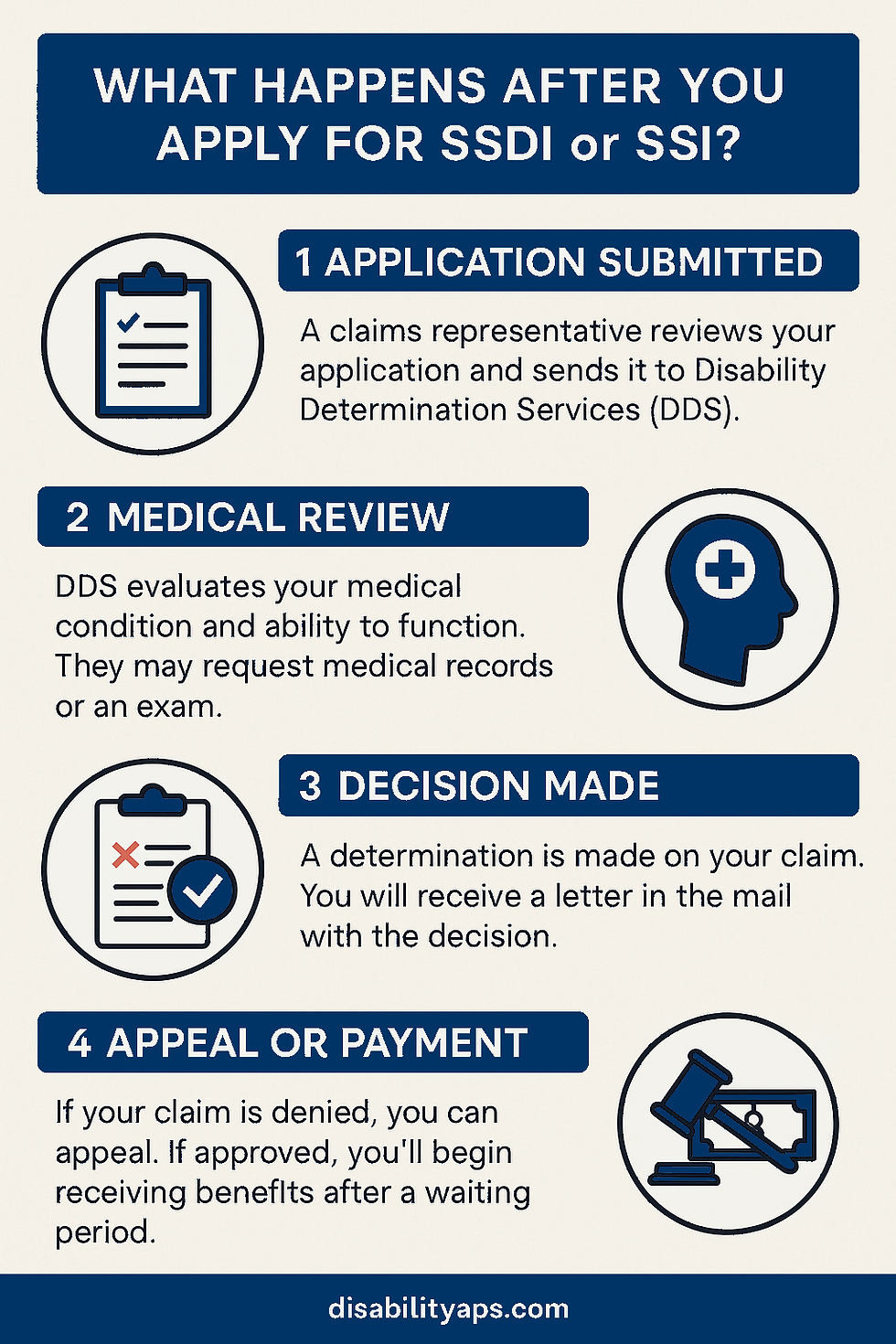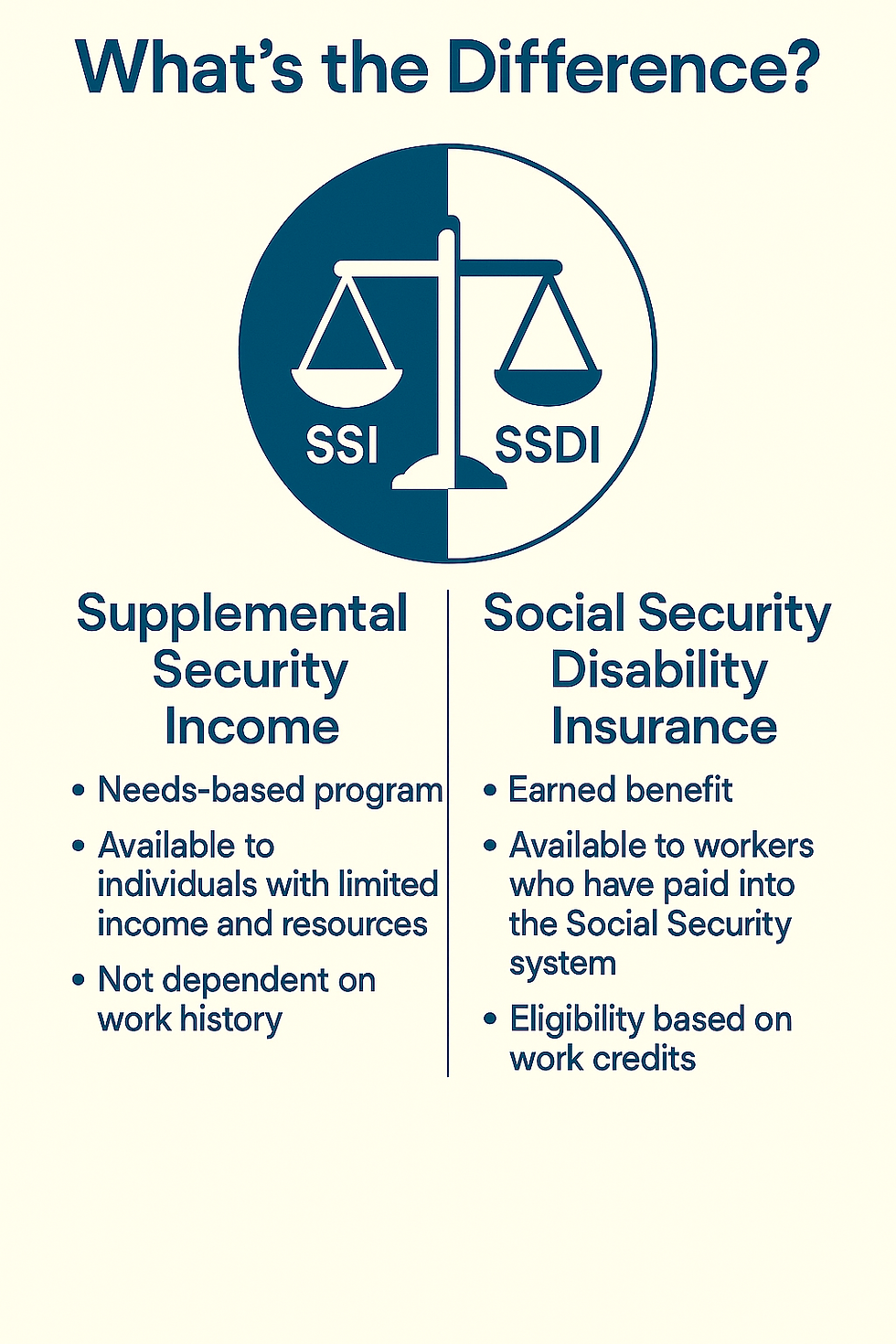Social Security Disability Benefits - What Happens After You Apply for SSDI or SSI?
- Advocate Pathway Solutions

- Oct 22
- 5 min read

Applying for Social Security Disability benefits can feel like a major milestone—and it is. But once your application is submitted, you may find yourself wondering what happens next. The truth is, the process can take time. Knowing what to expect at each stage can make all the difference in how you prepare and respond.
At Advocate Pathway Solutions, we believe that understanding the journey after your application is submitted can reduce stress, help you stay proactive, and increase your chances of approval. Here's what typically happens once your application for Social Security Disability Insurance (SSDI) or Supplemental Security Income (SSI) is filed.
Step 1: The Initial Review
After you submit your application — whether online, by phone, or at your local Social Security office — it goes through an initial review. This is where the Social Security Administration (SSA) checks to make sure your application meets the basic eligibility requirements.
During this step, the SSA is not yet deciding whether you are disabled. Instead, they are confirming things like:
Whether you have worked long enough and recently enough to qualify for SSDI benefits.
Whether your income and resources fall below the limits for SSI eligibility.
Whether your forms are complete and include the necessary signatures and documentation.
Whether you are currently working and how much you are earning.
If something is missing, such as incomplete medical forms, unsigned documents, or missing work history information, the SSA may contact you or your representative to correct it. Providing accurate and complete information from the start can help prevent unnecessary delays.
Once this basic screening is complete, the SSA sends your claim to Disability Determination Services (DDS) in your state for a medical review.
Step 2: Social Security Disability Benefits Review by Disability Determination Services (DDS)
DDS is the state agency that actually decides whether your medical condition meets the SSA's definition of disability. Their job is to evaluate all the medical and non-medical evidence in your case and determine whether you are unable to work due to your condition.
Here's what happens at this stage:
1. A Disability Examiner Is Assigned
A DDS examiner is assigned to your case. This person works closely with a medical consultant, usually a doctor or psychologist, to review your records and apply SSA's rules.
2. Gathering Medical Evidence
The examiner will review all the medical evidence you submitted with your application. If something is missing or unclear, DDS will request your treatment records directly from your doctors, hospitals, and clinics.
That's why it is so important to list every medical provider you've seen, along with accurate addresses and dates of treatment. The more complete your medical file, the faster and more accurately your claim can be evaluated.
3. Reviewing Functional Evidence
Beyond medical test results, DDS looks at how your condition affects your ability to function.
They consider things like:
Your ability to walk, stand, sit, lift or concentrate.
The side effects of medications.
Any hospitalizations or emergency room visits related to your condition.
Whether your condition limits your daily activities or ability to care for yourself.
In some cases, DDS may also contact you directly for clarification or to complete questionnaires about your daily activities or work history.
4. Comparing Your Case to the SSA's Listings
DDS will compare your medical condition to the Listing of Impairments, also known as the "Blue Book." This is a list of conditions that the SSA recognizes as severe enough to prevent work. If your medical records show that your condition meets or equals one of these listings, your case may be approved at this stage.
If it doesn't meet a listing, DDS will evaluate whether your condition prevents you from performing any substantial gainful activity (SGA). That is, earning above a certain income threshold, either in your past work or in any other type of job based on your skills, education, and age.
Step 3: The Consultative Examination (If Needed)
Sometimes the medical evidence in your file isn't enough for DDS to make a decision. When that happens, the SSA may schedule a Consultative Examination (CE). This is a medical exam performed by an independent doctor chosen and paid for by the SSA, not your own physician.
A consultative exam can include:
A physical examination, if you have physical impairments.
A psychological evaluation, if your claim involves mental health conditions.
Diagnostic tests such as X-rays, blood work, or pulmonary function tests.
The goal is to gather missing information, not to provide treatment. The examiner will prepare a report summarizing their findings and send it directly to DDS.
Tips for Consultative Exams
Show up on time. Missing your appointment can delay your claim or even result in a denial.
Be honest and thorough. Explain your symptoms clearly and describe how they affect your daily life.
Don't exaggerate, but don't minimize your pain or limitations either.
After your exam, DDS will add the doctor's report to your file and continue reviewing your case.
Step 4. The Disability Decision
Once DDS has all the necessary evidence, the disability examiner and medical consultant will make a decision.
You will receive a written decision letter in the mail from the SSA.
If You Are Approved:
Congratulations! This means SSA found that your medical condition prevents you from working and meets all program requirements.
If You Are Denied:
A denial does not mean the end of your case. It is simply the beginning of the next stage in the process. Many applicants are denied initially but are later approved on appeal.
You have 60 days from the date on your denial letter to file for reconsideration, which is the first level of appeal.
Common reasons for denial include:
Insufficient medical evidence.
The SSA believes you can still perform some type of work.
Failure to follow prescribed treatment.
Earning income above the Substantial Gainful Activity (SGA) limit.
If you are denied, don't give up! At this stage, it's often helpful to consult Advocate Pathway Solutions, a Certified Non-Attorney Representative who understands SSA rules and can help strengthen your claim for the next step.
Step 5: Reconsideration (If Denied)
During reconsideration, your case is reviewed by a different team at DDS. They will re-evaluate all of your evidence, along with any new medical records or statements you provide.
The majority of claims are still denied at reconsideration, but it is a crucial step before you can request a hearing before an Administrative Law Judge (ALJ).
Final Thoughts: Knowledge is Power
The Social Security Disability process can feel complex and slow. However, understanding what happens after you apply can make it much more manageable. Each step, from the initial review to the final decision, is part of a system designed to ensure fairness and accuracy in determining who qualifies for benefits.
By staying organized, keeping your medical information up to date, and seeking help when needed, you can greatly improve your chance of success.
Ready to move forward? Visit disabilityaps.com/contact-us and upload your information. We’ll clarify your eligibility, identify missing records, and chart the fastest path to approval.
Qualifying for Social Security Disability benefits isn’t about luck—it’s about meeting clearly defined rules and proving it with solid evidence. By understanding how SSA evaluates work history, financial need, and medical severity, you can decide whether to apply, avoid common mistakes, and present the strongest possible case. Whether you file on your own or enlist professional help, a proactive, organized approach can turn an overwhelming process into a manageable one—and bring you closer to the financial security you deserve.




Comments